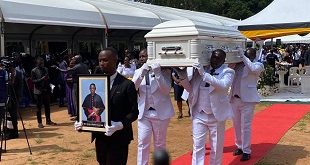
“What constitutes Ugandan art?” is what inquiring minds are asking artists flaunting their so-called Ugandan art. Sometimes the question is framed differently. How much of that art actually is Ugandan? This in consideration that the art may be made of oil paints made in Germany, canvas made in China, and all other materials imported from abroad. A search for answers reveals that Uganda art today faces a crisis of identity.
The existent divide in Uganda art, however, can best be seen between art practiced by college-trained artists and the one practiced by craftsmen littered along major highways and busy urban roads.
In Kampala the most famous hub is the Nsambya-Kabalagala stretch where informally-trained artists ply their trade. Their wares are simple wood carvings of furniture, wildlife and other trinkets that fly off their shelves on the cheap but some of them rake in millions from tourists and Uganda’s middle class.
Meanwhile, their ‘learned’ counterparts are locked away in private studios or at campuses. They sometimes present their work at exhibitions, hoping to catch some excited buyers looking for something more exotic or `high art’, as they like to refer to it in academia.
These artists emphasise their class by slapping obscenely high prices on their art and in U.S. dollars. Sadly, the prospects are not as rosy and thus there is a gross mismatch between what should be expected from a university-trained artist in terms of earnings and the so-called naïve artist by the roadside.
Some academics will argue that art is not primarily for making money, and that there lies the difference between modern and street art.
Prof. George Kyeyune of the Makerere Art School says the art school equips artists with the requisite visual language to be able to generate many possibilities, including communicating multifarious messages. Thus, the Makerere artist is not trained to be motivated by money as the chief concern but to use his art as a tool, just like a writer uses literary devices to write a piece of fiction purely for entertainment. These ideals are far removed from the mindset of a craftsman whose singular motive is to milk every penny he possibly can from the passerby. However, this craftsman does not wish to be discounted as any less an artist than his formally-trained counterpart.
This question of identity for art is neither new nor peculiar to Ugandan art. It is a subject that has been debated since colonial times and the introduction of formalism in Africa.
There has been a tendency to consider the so-called “naïve” art done by the informally-trained and illiterate artists as the genuine African or Ugandan art, with the thinking that contemporary art lost its “Africanity” the moment it adapted Western formalism.
One critic categorised those artists like the “roadside artists’’ and the informally or formally trained who have adapted phony African identities in their works as pseudo artists because their intentions are purely commercial and they have found this to be a useful sales strategy.
It can as well be described as naïve abstraction, which results more from lack of representational skill than the artists’ intentions. Such art was encouraged during colonial period in Africa, in order to produce an “authentic” African art untainted by western education and civilization. Colonial administrators used the works of these “instant” artists, who never had the least knowledge of what art was, to emphasize the savagery of the African. And, it has persisted as the definitional characteristic of modern African creativity. So then, what and where is Ugandan art?
****
editor@independent.co.ug
 The Independent Uganda: You get the Truth we Pay the Price
The Independent Uganda: You get the Truth we Pay the Price



